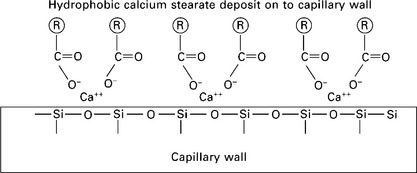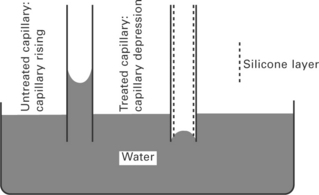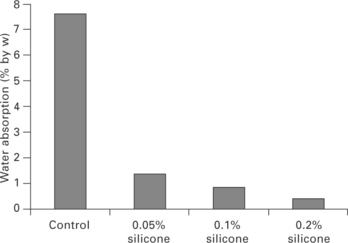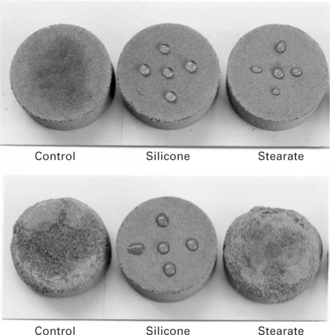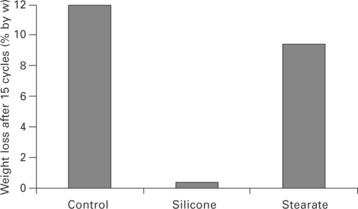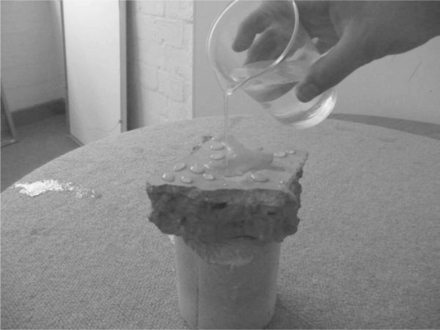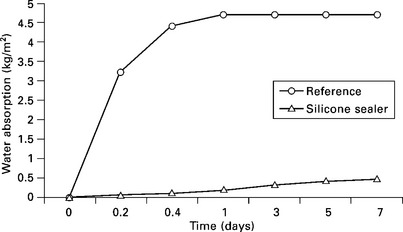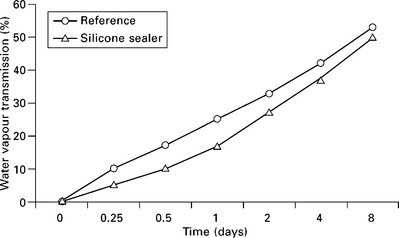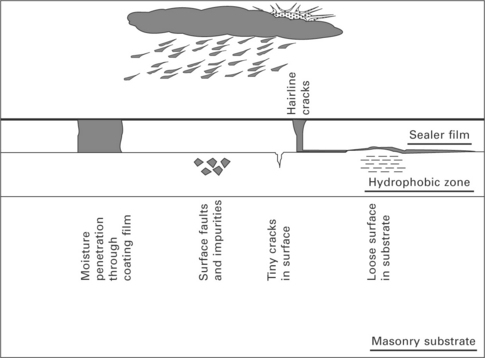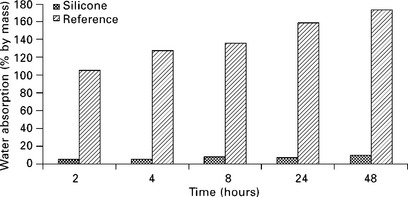Integral admixtures and surface treatments for modern earth buildings
Abstract:
This chapter discusses integral admixtures and surface treatments that impart important protection features to modern rammed earth buildings. The chapter first reviews the use of integral admixtures such as silicone water-repellents to provide protection against natural weathering. Other functional admixtures such as superplasticisers and set accelerators or retarders are then discussed. The chapter then considers surface treatments including vapour-permeable hydrophobic sealers such as silane/siloxane water-repellent impregnants, dust binders and surface coatings or renders.
silicone water-repellent admixtures
vapour-permeable hydrophobic sealers
10.1 Introduction
Integral admixtures and post-surface treatments of modern rammed earth buildings not only provide protection against natural weathering, but also improve the quality of the rammed earth construction. This chapter discusses modern technologies for treating rammed earth building materials using integral functional admixtures and surface treatments after construction.
Due to the permeable and hydrophilic nature of rammed earth building materials, water can easily penetrate into rammed earth buildings. Therefore water penetration becomes an important factor affecting the durability of rammed earth construction. The inherent weakness of earth in water makes the earth structure an impractical choice due to the subsequent deterioration under natural climatic conditions. Modern rammed earth building materials often contain a small amount of cement as a stabiliser to improve the durability of the rammed earth structure. However, due to the hydrophilic nature of the earth/cement material, which attracts water penetration, cement cannot solve the problems associated with water penetration for rammed earth buildings under natural weathering conditions.
When cement is added to rammed earth material, water permeation often leads to another problem: efflorescence. Efflorescence can have a detrimental effect on the appearance of modern rammed earth buildings. Efflorescence is caused by water movement within the capillaries of the masonry building material containing cement or lime. The moisture within the capillaries carries calcium hydroxide produced from cement hydration or existing lime within the substrate to the surface. The carbonation of calcium hydroxide by carbon dioxide in the atmosphere produces insoluble white calcium carbonate deposits. Efflorescence may also be caused by the transport of soluble salts either from the subsoil and aggregates or from ground water, which re-crystallise at the surface after water evaporation. This commonly shows as white streaks on vertical masonry wall surfaces. This deterioration is detrimental to the natural decorative appearance of cement-stabilised rammed earth buildings. Further, damp walls due to water penetration often lead to other water-based staining problems such as surface soiling or deposits of other staining materials.
Water penetration damages the thermal insulation properties of rammed earth buildings. Cold rammed earth walls caused by high moisture content within the wall require additional heating in winter. Cold walls caused by water penetration also often cause internal surface condensation resulting in problems such as mould growth and efflorescence on the internal wall surface.
Integral admixtures play an important role for rammed earth. A properly designed silicone water-repellent admixture effectively minimises water movement within the capillaries and hence not only reduces the water absorption, but solves other water-related problems as discussed above. The admixture does not affect the vapour permeability and the surface appearance of rammed earth buildings. Other water-repellent admixtures such as stearates or oleates are also effective for attaining water repellency-but these materials lack long term durability. Although it is uncommon to use other functional integral admixtures such as a plasticiser or a set accelerator or retarder for rammed earth materials, these admixtures, under special circumstances, can help to achieve certain desired properties for rammed earth materials.
Post-surface treatment is another way to protect rammed earth structures. Silicone water-repellents are useful sealers for rammed earth. The advantage of using silicone water-repellents is that this sealer penetrates into the capillaries and reacts with the substrate via strong siloxane bonding resulting in a long-term protection against natural weathering. Unlike other sealers, silicone impregnation does not affect the vapour permeability and the surface appearance of rammed earth buildings.
A water-resistant paint or coating such as a silicone masonry paint or a highly filled acrylic coating containing silicone water-repellent admixture can also provide a good protection against water penetration for rammed earth. Due to the permeable paint film structure, silicone masonry paint and highly filled acrylic coatings do not significantly affect the vapour permeability of rammed earth, but the coatings can alter the surface appearance of rammed earth construction. If a natural appearance is desired then water-repellent impregnation is a better choice.
Surface dust sealing is normally required for internal rammed earth walls Polyvinyl acetate (PVA), acrylic or styrene butadiene (SBR) latex emulsion are useful materials for sealing the internal surface of rammed earth walls as dust-binding sealers or dust suppressants. By selecting proper sealing material at a low concentration with a proper application method, internal dust sealing does not cause significant change in the surface appearance and vapour permeability of rammed earth walls.
To avoid reducing the vapour permeability of the substrate, it is not normal practice to undertake dust sealing for the exterior surface of a rammed earth wall. However, it is possible to carry out exterior dust sealing using a mixture of an acrylic or other polymer emulsion at low concentration and a silicone water-repellent admixture to achieve both dust binding and water repellency for rammed earth buildings if exterior dust sealing is required.
10.2 Integral admixtures for modern earth construction
Modern rammed earth construction is often stabilised by a small amount of cement. Cement remarkably improves the quality of rammed earth building. other admixtures such as bitumen, acrylic or latex emulsions and other polymeric materials may also be useful as stabilisation agents.1 However, cement, due to its low cost and wide availability, is the cheapest and the most efficient material to stabilise rammed earth material. It is not the main aim of this chapter to discuss various stabilisation admixtures, but the aim is to discuss integral functional admixtures whose purpose is to improve quality and to provide some important features to modern rammed earth building materials.
10.2.1 Hydrophobic admixtures
For many years, hydrophobic or water-repellent admixtures have been used in cementitious masonry building substrates including cement-stabilised rammed earth. At a small dosage such as 0.05% or less, water-repellent admixtures efficiently minimise moisture movement within the capillaries of substrates to reduce water absorption under natural weathering conditions. Such a water-repellent admixture does not block the capillaries of masonry substrates and therefore does not affect the vapour permeability of building materials and does not affect the surface appearance of the substrate. Figure 10.1 shows the effective water-repellent effect (or beading effect) on a pressed concrete block containing a silicone water-repellent admixture. Note: a pressed concrete substrate is made of sand and/or fine gravel, cement and pigment as a colouring agent and has very similar properties to that of a cement-stabilised rammed earth substrate that is made of cement and soil, which mainly contains sand (and/or fine gravel) and clay which is like pigment in pressed concrete. In this chapter, unless otherwise stated, most test results were based on standardised pressed sand/cement test substrates for the consistency of testing, as rammed earth is a very variable substrate.
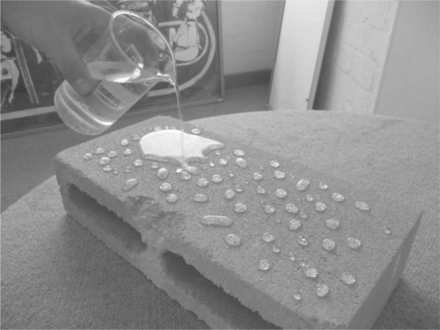
10.1 Effective water-repellent effect (or beading effect) on a pressed concrete block containing a silicone water-repellent admixture.
Oil- or fat-based water-repellent admixtures
Conventional hydrophobic admixtures are oil- or fat-based water-repellent admixtures such as stearates and oleates, which have been used for pressed concrete2 and cement-stabilised rammed earth for many years. These admixtures may be in the form of raw oil such as vegetable oil or other fatty acids, or may be made from animal fat or vegetable oil, for example, ammonium or calcium stearates or oleates in the forms of either aqueous emulsions or solid powders. These materials can achieve a satisfactory water-repellent effect for cement-stabilised rammed earth at an addition rate of approximately 0.1% by weight based on the active solid content of admixture. The water-repellent property is achieved by the hydrophobic admixture molecules within the rammed earth matrix where the individual active ingredient such as the oil or fat molecule can react with calcium present in the rammed earth material or any other masonry substrate to form calcium stearate or oleate, which are insoluble salts. These insoluble calcium stearates or oleates within the rammed earth matrix convert the hydrophilic nature of rammed earth into a hydrophobic material. Figure 10.2 represents the hydrophobic salt deposits within a pressed concrete substrate.
The long-term hydrophobic performance of these oil- or fat-based admixtures is found to be unsatisfactory due to the fact that they are not permanently bonded to the substrate, but exist as individual hydrophobic salt deposits within the substrate. These individual hydrophobic deposits are subject to many deterioration factors under atmospheric conditions. UV and natural weathering, for example, can effectively destroy these materials over a period of time. These oil- and fat-based materials can be effectively re-hydrolysed under strong alkaline conditions where cement is used in the rammed earth building. These admixtures are also subject to biological deterioration particularly under humid or wet conditions. The durability of these oil- or fat-based admixtures compared to that of the new silicone water-repellent admixtures will be discussed further in the following section.
Silicone water-repellent admixtures
The most recent hydrophobic admixture technology developed for rammed earth is silicone-based water-repellent admixture. This silicone admixture was initially developed by Victoria University in Australia in 1996 for pressed concrete substrates. The technology was successfully commercialised by an Australian company for the pressed concrete industry. This silicone water-repellent admixture was soon found to be equally effective for cement-stabilised rammed earth substrates and other cementitious masonry materials. Since 1997, a new silicone water-repellent admixture was introduced to the rammed earth industries both in Australia and overseas.
This silicone water-repellent contains reactive silanes and silxoanes, which effectively form a nanomolecular polysiloxane lining within the capillaries of the rammed earth substrate rather than blocking the masonry capillaries. Therefore, relatively small amounts of silicone are required to molecular-line the capillaries compared to the amount required to block the capillaries. However, molecular lining capillaries using small amounts of silicone can greatly reduce the surface tension of the substrate and convert the hydrophilic nature of masonry capillaries to a hydrophobic state. Figure 10.3 represents capillary rise due to a hydrophilic masonry capillary versus capillary depression due to a hydrophobic capillary treated with silicone water-repellent admixture.
The advantage of a silicone admixture is that the reactive silane and siloxane react with masonry ingredients via strong siloxane bonding and they also crosslink to form polysiloxane, which lines over the capillary wall of the substrate.3–6 Due to the chemical bonding, the polysiloxane lining becomes part of the rammed earth substrate resulting in long term durability compared to that of a traditional water-repellent admixture, which relies on a hydrophobic calcium stearate or oleate salt deposited within the capillaries. Figure 10.4 shows the silane reaction forming polysiloxane within a masonry capillary wall. The alkylalkoxysilane or siloxane first hydrolyses in the presence of water to form a silanol, which then reacts with the masonry substrate forming crosslinking nano-polysiloxane structures via siloxane linkages within the masonry matrix resulting in a permanent hydrophobic attachment to the treated masonry substrate.
The silicone admixture is effective in making cement-stabilised rammed earth water-repellent. At an addition rate of 0.05% based on the mass of the rammed earth, the silicone admixture achieves approximately 80% reduction in water absorption. Figure 10.5 shows a capillary water absorption result according to DIN 52617 using a pressed concrete test substrate containing a silicone admixture. A 24-hour water absorption result clearly indicates that the capillary water absorption of test substrates containing a silicone admixture is significantly reduced. The test result also indicates that the addition rate of 0.05% of silicone admixture was sufficient to make a water-resistant rammed earth substrate. Feedback from the rammed earth industry from different countries also confirmed that addition at a rate of 0.05% silicone admixture is sufficient in practice for most cement-stabilised rammed earth buildings.
The efficacy of the silicone admixture is further confirmed by a test carried out to model the resistance to wind-driven rain (water penetration under pressure) for pressed concrete block walls conducted by the Australian Commonwealth Scientific and Industrial Research Organisation (CSIRO) according to ASTM E514-90. This test is equivalent to wind-driven rain at a wind speed of 120 km/h (or 500 pa) against a single skin pressed concrete block wall containing 0.05% silicone admixture. The test device is shown in Fig. 10.6. The result shows that the test wall successfully passed the 4-day test period, which was far superior to the industrial standard (ASTM standard) of 4 hours. In comparison, a standard pressed concrete block wall without silicone admixture generally resisted water penetration for only 20 minutes under the same test conditions.
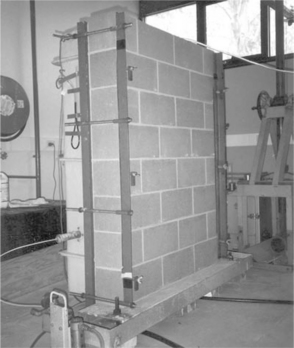
10.6 This device is used to test the equivalent to wind-driven rain at a wind speed of 120 km/h (or 500 pa) against a single skin pressed concrete block wall containing 0.05% silicone admixture.
Please note that the above outstanding result of resistance to water penetration under pressure provided by the silicone admixture within the pressed concrete wall should not be applied under a tanking situation of a rammed earth building such as when a part of building is constructed below the ground or in underground structures, or under a slope or a retaining wall situation. An appropriate waterproofing treatment such as using bituminous, polyurethane or other polymeric membranes together with a fabric membrane and installing an appropriate drainage pipe or a similar waterproofing measure according to the common building practice to prevent groundwater ingress to the walls or footings of the building is highly recommended.
Rammed earth containing a silicone water-repellent admixture shows a good resistance to rising damp. Rising damp in a masonry building is generally caused by moisture rising through the building footings and is a difficult problem for remedial treatment in buildings. Figure 10.7 shows the result of a rising damp test that was conducted by placing a pressed concrete block in a water bath for 24 hours. Results shown in Fig. 10.7 reveal that the block containing 0.05% silicone admixture was dry inside whilst the control was fully saturated with water due to rising damp (capillary water absorption). This test result clearly indicates that the silicone admixture in the treated substrate provided a good resistance to rising damp.
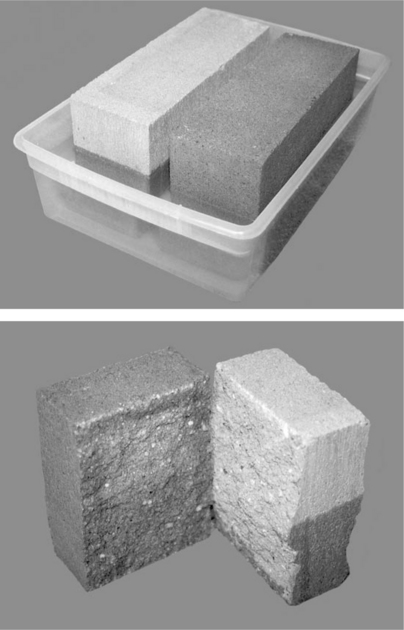
10.7 Result of a rising damp test conducted by placing a pressed concrete block in a water bath for 24 hours.
Despite a good resistance to rising damp offered by this silicone water-repellent admixture, an effective damp course of either chemical damp-coursing or appropriate fabric or plastic membrane damp-coursing material should be properly installed according to common building specifications when a rammed earth building is constructed.
The resistance to efflorescence endowed to rammed earth substrates by silicone water-repellent admixture is significant. Table 10.1 shows the results of an accelerated efflorescence test for a pressed concrete substrate. The test was conducted by laying the test substrate into a tray containing 10% sodium sulfate solution at a depth of 10 mm (less than 30% of the substrate total height) for 7 days. The top surface of the substrate above the solution was visually examined for evidence of efflorescence. The test results in Table 10.1 indicate that the substrate containing 0.05% silicone water-repellent admixture showed no evidence of efflorescence after 7 days of the test period, whilst the control was fully covered with efflorescence within 1 day. The efflorescence of the sample containing 0.025% of the silicone admixture was also significantly reduced compared to that of the control substrate.
An efflorescence test in outdoor conditions was conducted by using commercial pressed concrete blocks under natural weathering conditions in Tasmania, Australia for seven years (as shown in Fig. 10.8). The result indicates that the block containing 0.05% silicone admixture showed remarkable resistance to efflorescence against natural weathering. The treated samples remained in almost the original condition after seven years, whilst the control blocks showed a poor surface appearance mainly due to efflorescence (white salts) and other water-based staining problems associated with water penetration.
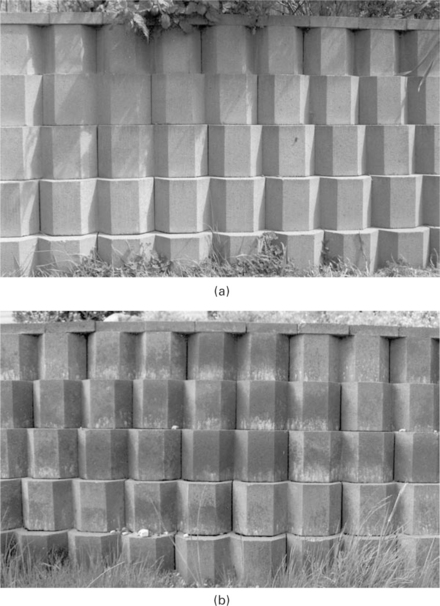
10.8 Examples of commercial pressed concrete blocks that underwent natural weathering conditions in Tasmania, Australia for seven years. (a) Pressed concrete blocks containing 0.05% silicone admixture, (b) Control blocks.
The durability of rammed earth is also significantly improved by incorporating silicone water-repellent admixture. A durability test was conducted by an accelerated salt erosion test. A pressed concrete substrate was dipped into a 10% sodium sulfate solution for 12 hours and subsequently dried at 80 °C in an oven for 12 hours. This was repeated over many cycles. The ingress of salty water into the substrate and drying can result in serious damage to substrates due to repeated salt crystallisation, which expands in the capillaries of the substrate. in this test, treated samples containing 0.05% silicone admixture and a control of standard pressed concrete substrate were used. A substrate containing conventional stearate water-repellent admixture was also used as a comparison sample.
The salt erosion test demonstrated that after 15 cycles of dipping and drying, the disc with silicone admixture remained almost unchanged, whilst the control commenced to erode after five cycles. The sample with silicone admixture still showed a good water-repellent effect at the end of the erosion tests. The test also indicated that the sample with the stearate admixture showed some resistance to erosion during the early cycles, but the erosion accelerated after 10 cycles. Figure 10.9 shows the pressed concrete substrates before and after 15 cycles of the salt erosion test. This test confirms that the durability of the concrete with silicone admixture is significantly improved compared to that of the control and the test also indicates that the result with silicone admixture is superior to that of a traditional oily-based admixture.
Figure 10.10 shows the weight losses of the test substrates after 15 cycles. The substrate containing silicone admixture almost retained its original mass, whilst the control lost 12% and the sample with stearate lost 9% of its total weight. This result again confirmed that the durability of the substrate containing silicone admixture was superior to that of the sample without admixture. The traditional stearate admixture was not sufficiently resistant for long term protection against erosion from natural weathering.
The method of use of silicone water-repellent admixture is simple and cost effective. The admixture is simply pre-mixed into the rammed earth soil mixture before being rammed into the form work. The water-repellent rammed earth substrate is already formed after the mould is removed. No further procedure or extra post-treatment is required for the construction. However, it is worthwhile to mention that, due to the immediate surface water repellency, further spraying of water onto the ready-formed rammed earth structure in order to help cement curing becomes difficult after the mould is removed. Therefore, it is important to retain the moisture level within the rammed earth substrate during the curing period in order for the cement to cure completely. It is recommended to keep the rammed earth in the mould for a slightly longer time in order to achieve better curing. It is also recommended to cover up the freshly made rammed earth wall before and after the mould is removed until the rammed earth is fully cured. In fact, preventing water contact with freshly made rammed earth walls also prevents initial efflorescence occurring, which is a common problem for cementitious materials during the early curing period.
10.2.2 Other integral admixtures
Apart from the polymeric binding materials (which are not discussed in this chapter) and the hydrophobic admixtures as discussed in the previous section, other integral admixtures, such as superplasticisers, set accelerators and retarders, are not commonly used in rammed earth. There have been hardly any case studies or practical applications of other integral admixtures for the stabilised rammed earth building materials or other earth building substrates. The integral admixtures discussed in this section will be limited to the cement-stabilised rammed earth materials with similar properties to that of dry-pressed concrete. For example, the rammed earth soil used in Australia often contains sand and gravels with limited clay content (generally at less than 8–10% clay) and approximately 8–10% cement is used as a stabiliser. The property of this rammed earth material is similar to that of dry-pressed concrete. Theoretically, many integral admixtures which are suitable for dry-pressed concrete should be useful for this type of rammed material if certain properties of the rammed earth material are required. However, as mentioned above, integral admixtures apart from hydrophobic admixture are not practically used in Australia and the authors have no feedback from the rammed earth industry that these admixtures are practically used in other parts of the world.
Workability and compaction enhancement
Superplasticisers are commonly used in dry-pressed concrete to improve the workability and to enhance the compaction of concrete for increasing density and to improve the surface finish of the concrete product. These admixtures should be equally effective for cement-stabilised rammed earth materials, which have similar properties to those of dry-pressed concrete. Lignosulfonate, sulfonated naphthalene condensate or sulfonated melamine or polycarboxylate ethers are commercially available superplasticisers that should be effective for rammed earth materials. Due to the variation of natural soil components from place to place, a test for the compatibility and effectiveness for local rammed earth soil should be individually conducted if an admixture is selected in practice.
A silicone water-repellent admixture has been found to be effective as a superplasticiser apart from being a water-repellent admixture for rammed earth materials. Silicone is used as a release agent and workability or compaction enhancement agent for many uses. It is not surprising that silicone is useful as a superplasticiser for rammed earth material. Feedback from rammed earth builders in Australia, who have used silicone water-repellent admixtures has confirmed that workability and compaction is enhanced by adding the silicone water-repellent admixture. A rammed earth wall containing silicone admixture tends to have higher density and better surface appearance. This superplasticiser effect offered by a silicone admixture may not be as effective as that of a commercially available purpose-designed superplasticiser, but is an added benefit for rammed earth building.
Set accelerators and retarders
Like concrete, rammed earth containing cement sets fast in summer and slowly in winter. Too fast or too slow setting adversely affects the quality of rammed earth construction. Therefore a set accelerator or retarder becomes useful in the above-mentioned cement-stabilised rammed earth under extreme climatic conditions to adjust the setting rate.
There are many commercially available cement set accelerators available on the market. A typical material used for cement acceleration is calcium chloride (CaCl2). Sodium chloride (NaCl) may also be effective as a cement accelerator. Calcium chloride can effectively accelerate cement hydration to increase early strength and shorten the setting time for concrete. Theoretically, this set accelerator should be equally effective for the above-mentioned cement-stabilised rammed earth if fast setting is required. However, builders should conduct testing for the set accelerator selected for each project to alleviate negative effects due to the use of a set accelerator. It is also worthwhile to mention that chloride ions present in the set accelerator can potentially promote corrosion activity of steel reinforcement if used in the reinforced rammed earth construction, especially in moist environments.
Cement retarders are not commonly used in the concrete industry nor in the rammed earth industry. However, like accelerators, cement retarders used in the concrete industry should also be effective for cement-stabilised rammed earth. In practice, we have found that many chemical admixtures such as hydrophobic admixtures and superplasticisers have some effect on cement setting (generally a retarding effect). Such a retarding effect due to the chemical admixture may become significant when the temperature is low in winter. Evidence shows that a silicone admixture, for example, slows down cement setting for pressed concrete and cement-stabilised rammed earth, although such an effect may not be significant due to the low dosage rate. It is understandable that crosslinking between silcone molecules and cement and other rammed earth ingredients will adversely affect cement curing (cement crosslinking within rammed earth). In practice, we found that silicone admixtures slighly slow down the cement setting in rammed earth, but the effect is negligible under normal climatic conditions. However, it is worthwhile to maintain maximum curing conditions by keeping the rammed earth in the mould slightly longer in order to achieve sufficient curing, particularly when the atmospheric temperature is low. It is also important to prevent moisture loss from the rammed earth during the curing period, particularly when the atmospheric temperature is high.
10.3 Surface treatment for modern earth buildings
Surface treatment is commonly undertaken and can achieve many desired properties for rammed earth buildings. Surface treatment includes water-repellent sealing, surface rendering, waterproofing or decorative coating and surface binding or dust suppressant sealing.
10.3.1 Vapour-permeable water-repellent sealing
When choosing a sealer to repel water from exterior rammed earth walls, the vapour permeability of the treatment should be considered and the original surface finish of the rammed earth should also be maintained. Sealers made from polyvinyl acetate (PVA), acrylic or latex emulsions, and other polymeric materials are generally not ideal materials for water-resistant treatment of rammed earth. This is because these materials are film-forming materials that will block the vapour permeability and change the surface appearance of rammed earth. although sealers such as acrylic or latex emulsions are water-resistant and durable materials, protection will not be achieved with these materials. This is because the water resistance relies on a continuous film formed on the rammed earth surface by the sealer. This film is generally a clear thin film that is easily damaged by either physical abrasion or natural deterioration such as UV radiation or harsh weathering resulting in poor durability of the treatment.
A silicone water-repellent is a highly effective material for sealing masonry building materials.7 Commonly used silicone sealers include siliconate, alkylalkoxysilane and siloxane (see Fig. 10.11). A silicone sealer has a relatively small molecular size so can effectively impregnate into the capillaries of the substrate forming a deep water-repellent layer (or hydrophobic zone) within the substrate rather than forming a continuous thin film over the surface. A silicone is a highly reactive material, which can crosslink with masonry substrates forming a polysiloxane molecular lining within the capillary walls of the masonry substrate via chemical bonding. This polysiloxane molecular lining is highly hydrophobic, which can effectively reduce capillary water penetration into substrates. Figure 10.12 shows a practical hydrophobic zone formed by a silicone sealer in concrete. The treated zone becomes hydrophobic due to the polysilloxane molecular lining from the silicone sealer. Figure 10.13 presents the water absorption data on rammed earth substrates impregnated with a silicone sealer. The figure indicates that the water absorption of the treated substrate is significantly reduced compared to that of the control.
As a hydrophobic molecular lining by a silicone impregnant does not block the capillaries, the water vapour permeability of treated substrates is not changed. Figure 10.14 demonstrates the unaffected vapour transmission of a masonry substrate treated with a silicone sealer by blowing air through the substrate. Figure 10.15 reveals the vapour permeability data of a rammed earth substrate treated with a silicone water-repellent sealer. The data indicate that the water vapour permeability of the rammed earth substrate treated with silicone sealer is almost the same as that of the untreated sample.

10.14 Unaffected vapour transmission of a masonry substrate treated with a silicone sealer demonstrated by blowing air through the substrate.
As a silicone water-repellent impregnant is a non-film forming material, it does not change the surface appearance of the rammed earth substrate.
We know that water penetration is one of the main causes of efflorescence and water-borne staining. Moisture is also a good medium for algae and other micro-organisms to grow on the surface. As discussed in the admixture section, it is understandable that efflorescence caused by water movement within the capillaries of masonry substrates will be significantly reduced if the substrate is treated with a silicone water-repellent sealer. Silicone water-repellent treatment keeps the surface dry and therefore protects the substrate against dirt pick-up, water-borne staining and the growth of microorganisms.
The durability of silicone water-repellent sealers is excellent for rammed earth buildings. The polysiloxane hydrophobic molecular lining formed by the silicone sealer within the capillaries of the rammed earth substrate is not affected by common factors such as physical abrasion, UV radiation or harsh weathering. Crosslinking via strong chemical bonding between the substrate and polysiloxane within the capillaries makes the silicone sealer part of the substrate, which is hardly affected by normal climatic conditions. Although the surface water-repellent effect (surface beading) may be quickly reduced by UV or physical abrasion, the internal hydrophobic zone within the substrate surface is not affected. This internal hydrophobic zone provides a durable water-repellent function to the rammed earth substrate against water penetration. The durability of the treatment with silicone sealer generally lasts over 10 years in practice.
10.3.2 Surface binders or dust suppressants
When sealing internal rammed earth walls, water resistance may not be important but dust binding or dust suppressing becomes the main aim. It is important that the original rammed earth finish should be maintained after the sealing. Water-based materials such as acrylics, latexes, PVA or other polymer emulsions are commonly used as materials for internal dust sealing. The sealer needs to be diluted to a low solid content in order to provide effective dust binding but impart minimal change in the surface appearance and the vapour permeability of the rammed earth building. For treating wet areas such as kitchens and bathrooms, water-resistant materials such as acrylic or latex emulsions should be used. PVA emulsion is not recommended for wet areas because PVA is a water-sensitive material.
The above-mentioned dust-sealing materials generally contain approximately 50% solids as a water-based emulsion. The material is required to be diluted with water at approximately 10–20% solids to form a working emulsion. The dilution rate may vary but should be controlled so that no film forming or a very light film is obtained over the treated surface with no significant change in the surface appearance. Spray application is preferred and two or more applications may be required depending on the permeability of the surface. It is important not to over-apply the sealer to avoid significant change to the surface appearance or the blocking of vapour permeability.
It is not recommended that dust sealing be applied to the exterior surface of rammed earth buildings. If sealing of exterior surfaces is undertaken then it requries a heavy application in order to provide sufficient dust binding against harsh weathering. However, the heavy application of dust sealer not only changes the surface appearance, but also blocks the vapour permeability of the rammed earth. This is because the sealing material such as acrylic or latex emulsion is a strong film-forming material that forms a continuous film over the substrate surface if applied heavily. Water can penetrate through the film via hairline cracks or small surface faults to wet the rammed earth behind the sealer film. Repeated water penetration will weaken the adhesion between the sealer film and the substrate, and water vapour behind the sealer film from the inside of the rammed earth wall will push the surface film off the substrate eventually causing delamination of the sealer. Figure 10.16 indicates the factors that affect the durability of the sealer.
If exterior dust sealing is required, a light dust-binding sealer containing silicone water-repellent may be used. In order to withstand harsh exterior weathering, a silicone water-repellent is highly recommended as an admixture to add into the dust sealer to make a combination of dust binding and water-repellent sealer. Adding from 1–5% silicone water-repellent into an acrylic or a latex emulsion containg a resin solid of 5–10% is highly recommended for exterior dust-binding treatment. Silicone penetrates into the substrate forming a deep hydrophobic zone behind the surface film formed by the dust sealer. This deep hydrophobic zone formed by the silcone water-repellent covers faults, small cracks and loose surfaces in the substrate and acts as a second but much more effective water-repellent barrier. This barrier resists water penetration if the top sealer fails to stop water penetration due to hairline cracks and film faults. The silicone hydrophobic zone also provides a constant dry interface between the acrylic sealer and the substrate surface, resulting in a good adhesion between the dust sealer film and the substrate surface. The water vapour permeability of this combination sealer is not significantly affected due to the light dust sealing used. This negates the risk of film delamination under the harsh weathering conditions for earth buildings. The durability of treatment with this combination of dust binding and water-repellent sealer is significantly improved. Figure 10.17 indicates the advantages of a silicone admixture for an exterior dust sealer.
The data in Table 10.2 clearly indicate the advantage of a silcone water-repellent admixture added to an acrylic sealer for rammed earth substrates. The acrylic sealer contains 10% solid added with 5% silane/siloxane emulsion as water-repellent admixture. The water absorption of the treated rammed earth substrate is significantly improved compared to that of the sealer without silicone water-repellent. The silicone water-repellent also achieves 0.5 mm penetration into the substrate, which is significant compared to that of pure acrylic emulsion sealer. Normal acrylic emulsion generally achieves almost no depth of penetration into rammed earth substrates.
10.3.3 Rendering and coating
Rammed earth wall surfaces are generally left untouched to give the wall the original colour and texture of natural earth. Regular horizontal lines from the wooden or steel formwork used in constructing the wall and subtler horizontal strata from the successive compacted layers of earth enhance the natural beauty of the rammed earth walls.
However, like any masonry wall, a rammed earth wall can be rendered if it is required. Renders such as traditional sand/cement render, polymer modified cement render and pure polymer (acrylic) render are all suitable for rammed earth walls. Render generally has a porous and permeable structure, which does not change the vapour permeability of rammed earth but provides no protection against water penetration under natural climatic conditions. Adding a water-repellent admixture into a render is a simple and cost-effective way to provide a significant protection against natural weathering for rammed earth buldings. Silicone water-repellent admixture not only increases reistance to water penetration, but also imparts resistance against water-based staining to the rendered surface. Figure 10.18 shows the water-repellent and anti-staining effect (against water-based ink) of an acrylic render containg a silicone water-repellent admixture. The render with silicone admixture shows a good water-repellent effect whilst the control shows complete absorption. After washing with water, the render containing silicone admixture shows no remaining ink mark whilst the control shows a permanent ink stain left on the surface.
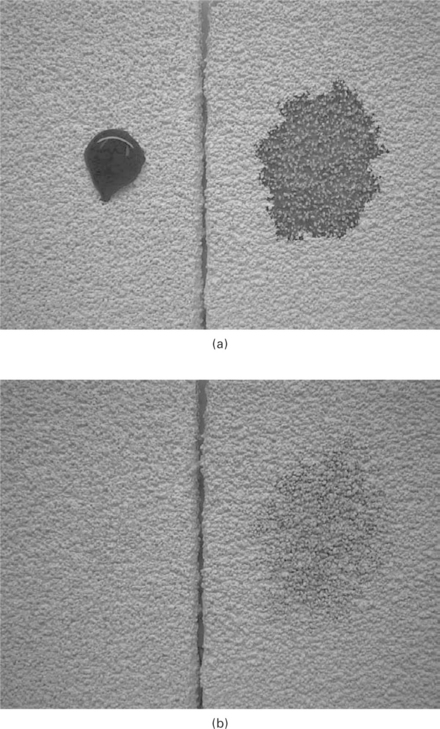
10.18 Water-repellent and anti-staining effect (against water-based ink) of an acrylic render containing a silicone water-repellent admixture. (a) Before washing, (b) after washing.
The following is an example of a simple earth render mix that can be easily produced by rammed earth builders or earth building owners. The advantage of this render is in the use of local soil, which provides the same colour to the earth building. Further, this earth render system is simple and cost effective. This render has been practically used in Melbourne, Australia for the last 10 years and has proven to be a durable system for earth buildings in practice.
The above render mix is made of locally available dry soil preferably with less than 10% clay content as the main render ingredient. Clean sand may be added into the render mix if the local soil contains a high clay content. A high clay content generally causes cracking after rendering. An acrylic, PVA, SBR latex or other polymeric emulsion is used as a binder which imparts a long-lasting binding and adhesion as well as flexibility to the earth render. Silicone water-repellent admixture imparts water repellency to the entire body of the earth render. The above render is mixed with water to a consistent slurry that can be applied to the rammed earth surface with a brush, roller or airless spray. To further improve the durability of the render, a silicone water-repellent sealer is applied as a top finish sealer to provide significant protection for both render and the rammed earth wall behind the render to form a complete protection system against weathering. Tests have shown that the above rendering system provided over 90% reduction in water absorption while still maintaining approximately over 80% vapour permeability for the earth substrate.
If the earth wall requires surface coating with a paint, a vapour-permeable coating is highly recommended. Silicone masonry paint is useful for rammed earth buildings. Silicone paint contains a silicone resin as a binder, which not only provides binding for the paint body but also imparts significant water repellency to the paint film. The advantange of silicone masonry paint is that it has good vapour permeability due to its highly filled paint film. The silicone binder provides a good resistance to water penetration to provide significant protection against natural weathering. However, the high cost of silicone paint makes it less viable for rammed earth buildings.
Acrylic coatings with a high resin concentration or low pigment volume concentration (PVC) also have good water resistance and the coating is generally recommended for exterior application. However, such water-resistant acrylic coatings have been proven to exhibit poor vapour permeability due to their high resin concentration within the paint formula. The poor vapour permeability is not an ideal option for coating the exterior walls of rammed earth buildings. Highly filled acrylic coatings (e.g. with a high PVC) offer good vapour permeability but poor water resistance due to their porous and permeable film structure. By adding a small amount of silicone water-repellent admixture, highly filled acrylic coatings can achieve similar properties to those of silicone paints such as good water resistance and high vapour permeability. Figure 10.19 shows the water absorption of a highly filled acrylic coating with a 1% silicone water-repellent admixture. The water absorption results indicate that water absorption of the coating film was significantly reduced by adding the silicone admixture.
10.4 Future trends
Rammed earth buildings have been in existence for thousands of years. Recently the quality of rammed earth construction has been dramatically improved by the breakthrough of incorporating very small amounts of specific silicone water-repellent admixtures into the structure via nanotechnology to achieve vast improvements in durability. In this chapter, we have discussed this admixture and other integral functional admixtures as well as post treatment for rammed earth to impart some important properties to the rammed earth building.
The development in recent years of integral silicone water-repellent admixtures is considered to be a great invention for pressed concrete. Further, silicone admixtures dramatically improve the quality of rammed earth substrates. Other admixtures such as superplasticiser and set accelerators or retarders can also impart important functions to rammed earth, although these admixtures are not practically used for rammed earth. In the future, research should be undertaken into admixture materials that can further improve the quality of rammed earth buildings or that impart special functions to the rammed earth construction, or a combination of admixtures that can impart multiple functions to the rammed earth materials. For example, an admixture may be incorporated not only to provide a water-repellent effect, but also to provide oil-repellent properties to the rammed earth building. This would prevent water- and oil-based staining. Fluorinated chemicals such as fluorinated silane/siloxane or fluorinated acrylic polymers may be used for this purpose although these materials are currently too expensive as admixtures for rammed earth. Other admixtures may be incorporated to improve the thermal insulation properties of the rammed earth. For example, hollow glass beads made from recycled glasses recently developed for cementitious materials should also be useful for rammed earth to increase thermal insulation properies. These hollow glass beads decrease the density of the substrate without affecting the strength. They are also found to be effective in improving the workability of cementious materials. Anti-mould or anti-algae agents used in emulsion paints, for example, should also be effective for rammed earth buildings. The anti-mould function would be important for rammed earth buildings in areas where mould and algae growth is a problem. So there are enormous possibilities within existing or new additives to enhance the durability of rammed earth buildings.
Post treatments such as sealing, coating and rendering are equally important for improving quality or imparting more functions to rammed earth buldings. For example, fluorinated silicones or fluorinated acrylic polymers are already used as anti-staining sealers (oil repellent) for masonry substrates. These materials should also be effective for rammed earth buildings. The oil-repellent (stain resistant) sealer would be ideal for areas like kitchens, bathrooms or public areas where repeated cleaning is required. Repeated cleaning of a rammed earth surface is not practically recommended as the rammed earth surface is not strong enough for repeated harsh cleaning. Nano-acrylic emulsion, for example, is another new technology for paint primers to enhance penetration. This nano-acrylic emulsion would be an ideal material for sealing rammed earth for dust binding for either internal and external surfaces. Due to the small size of the particles, this nano-acrylic would have less impact on vapour permeability and the surface appearance of rammed earth than traditional acrylic or latex emulsions.
10.5 Sources of information
Unless otherwise stated, the information and data used in this chapter come mainly from internal test reports, technical data sheets and product brochures of Tech-Dry Building Protection Systems Pty Ltd. Some of the data have been previously published in professional magazines, conferences and seminars over the last 10 years. All the data and publications are available by contacting Dr Ren Kebao, Tech-Dry Building Protection Systems Pty Ltd at 177 Coventry Street, South Melbourne, Victoria 3205, Australia or visit the website: www.techdry.com.au.
10.6 References
1. Middleton, G.F. Bulletin 5, Earth-Wall Construction. CSIRO Division of Building, Construction and Engineering; 1987.
2. Russell, P., Concrete Admixtures. Viewpoint Publication, 1983:14.
3. Ohama, Y., Demura, K., Wada, I., Inhibiting alkali-aggregate reaction with alkyl alkoxy silanes. The 9th International Conference on Alkali-Aggregate Reaction in Concrete. 1992:750–757.
4. Ren, K., Investigation of impregnants for low-cost buildings PhD thesis. Victoria University of Technology, 1995.
5. Silfwerbrand, J., Water-repellent Treatment of Building Materials: Hydrophobe IV. Proceedings of Fourth International Conference on Water Repellent Treatment of Building Materials. Aedificatio Publishers, Stockholm, Sweden, 2005.
6. Kaesler, K., Water-based siloxane emulsions as water repellents for masonry and concrete Chapter 11. Coatings for Masonry and Concrete, conference papers, Brussels, 30 June–1 July. The Paint Research Association, Teddington, 2003.
7. De Clercq, H., Charola, A.E., Water Repellent Treatment of Building Materials: Hydrophobe V. Proceedings of Fifth International Conference on Water Repellent Treatment of Building Materials. Aedificatio Publishers, Brussels, Belgium, 2008.

